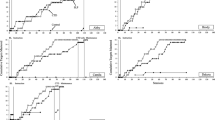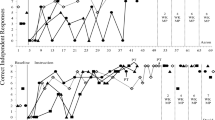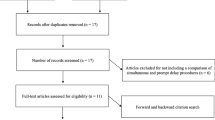Abstract
The purpose of this study was to compare the effects of constant time delay delivered with high procedural fidelity to constant time delay with high procedural fidelity on all variables except delivery of the controlling prompt (i.e., on a mean of 44% of the trials, the controlling prompt was not delivered when it should have been provided). Six preschool children with disabilities were taught to identify photographs in two alternating conditions (e.g., high procedural fidelity and low procedural fidelity). An adapted alternating treatments design was used to evaluate the instructional conditions on the effectiveness and efficiency of instruction. In addition, daily measures were taken of the teacher's implementation of each step of the constant time delay procedures which indicated that the two conditions were implemented as planned. The results indicate that both conditions were effective for four children; for three of these, the high procedural fidelity condition resulted in more efficient learning. For the fifth child, the high-fidelity condition resulted in criterion level responding, but the low fidelity condition did not. However, when the high fidelity procedure and trial-by-trial reinforcement were used for the low-fidelity stimuli, these also were acquired. For the sixth child, neither procedure was effective; thus, the high fidelity condition was used alone and resulted in learning. The results are discussed in terms of using the constant time delay procedure and studying the procedural fidelity of other strategies.
Similar content being viewed by others
References
Ault, M. J., Gast, D. L., & Wolery, M. (1988). Comparison of progressive and constant time delay procedures in teaching community-sign word reading.American Journal of Mental Retardation, 93, 44–56.
Ault, M. J., Wolery, M., Gast, D. L., Doyle, P. M., & Eizenstat, V. (1988). Comparison of response prompting procedures in teaching numeral identification to autistic subjects.Journal of Autism and Developmental Disabilities, 18, 627–636.
Billingsley, F. F., White, O. R., & Munson, R. (1980). Procedural reliability: A rationale and an example.Behavioral Assessment, 2, 229–241.
Bradley-Johnson, S., Sunderman, P., & Johnson, C. M. (1983). Comparison of delayed prompting and fading for teaching preschoolers easily confused letters and numbers.Journal of School Psychology, 21, 327–335.
Browder, P. M., Morris, W. W., & Snell, M. E. (1981). Using time delay to teach manual signs to a severely retarded student.Education and Training of the Mentally Retarded, 16, 252–258.
Gast, D. L., Ault, M. J., Wolery, M., Doyle, P. M., & Belanger, S. (1988). Comparison of constant time delay and the system of least prompts in teaching sight word reading to students with moderate retardation.Education and Training in Mental Retardation, 23, 117–128.
Handen, B. L., & Zane, T. (1987). Delayed prompting: A review of procedural variations and results.Research in Developmental Disabilities, 8, 307–330.
Kerr, J. Y. K. (1979).Photo cue cards. Tucson, AZ: Communication Skill Builders, Inc.
Kleinert, H. L., & Gast, D. L. (1982). Teaching a multihandicapped adult manual signs using a constant time delay procedure.Journal of the Association for the Severely Handicapped, 6(4), 25–32.
LeLaurin, K., & Wolery, M. (1992). Research standards in early intervention: Defining, describing, and measuring the independent variable.Journal of Early Intervention, 16, 275–287.
Mattingly, J. C., & Bott, D. A. (1990). Use of a constant time delay procedure in teaching multiplication facts to mildly handicapped students.Exceptional Children, 56, 438–449.
McDonnell, J. (1987). The effects of time delay and increasing prompt hierarchy strategies on the acquisition of purchasing skills by students with severe handicaps.Journal of the Association for the Severely Handicapped, 12, 227–236.
McDonnell, J., & Ferguson, B. (1989). A comparison of time delay and decreasing prompt hierarchy strategies in teaching banking skills to students with moderate handicaps.Journal of Applied Behavior Analysis, 22, 85–91.
McEvoy, M. A., Shores, R. E., Wehby, J. H., Johnson, S. M., & Fox, J. J. (1990). Special education teachers' implementation procedures to promote social interaction among children in integrated settings.Education and Training in Mental Retardation, 25, 267–276.
Miller, U. C., & Test, D. W. (1989). A comparison of constant time delay and most-to-least prompting in teaching laundry skills to students with moderate retardation.Education and Training in Mental Retardation, 24, 363–370.
Newborg, J., Stock, J., Wnek, L., Guidubaldi, J., & Svinicki J. (1984).Battelle Developmental Inventory. Allen, TX: DLM Teaching Resources.
Peterson, C. A., & McConnell, S. R. (1993). Factors affecting the impact of social interaction skills interventions in early childhood special education.Topics in Early Childhood Special Education, 13, 38–56.
Schoen, S. F., & Sivil, E. O. (1989). A comparison of procedures in teaching self-help skills: Increasing assistance, time delay, and observational learning.Journal of Autism and Developmental Disorders, 19, 57–72.
Schuster, J. W., Gast, D. L., Wolery, M., & Guiltinan, S. (1988). The effectiveness of a constant time delay procedure to teach chained responses to adolescents with mental retardation.Journal of Applied Behavior Analysis, 21, 169–178.
Schuster, J. W., Griffen, A. K., & Wolery, M. (1992). A comparison of constant time delay procedure and simultaneous prompting in teaching food words to elementary-aged students with moderate mental retardation.Journal of Behavioral Education, 2, 305–325.
Sindelar, P. T., Rosenberg, M. S., & Wilson, R. J. (1985). An adapted alternating treatments design for instructional research.Education and Treatment of Children, 8(1), 67–76.
Stevens, K. B., Blackhurst, A. E., & Slaton, D. B. (1991). Teaching memorized spellings with a microcomputer: Time delay and computer assisted instruction.Journal of Applied Behavior Analysis, 24, 153–160.
Touchette, P. E. (1971). Transfer of stimulus control: Measuring the moment of transfer.Journal of the Experimental Analysis of Behavior, 15, 347–354.
Wilbers, J. S., & Wolery, M. (1991, May).Effects of high and low procedural fidelity during the response interval of constant time delay. Paper presented at the Annual Conference of the Association for Behavior Analysis, Atlanta, GA.
Wolery, M., Ault, M. J., & Doyle, P. M. (1992).Teaching students with moderate and severe disabilities: Use of response prompting strategies. White Plains, NY: Longman.
Wolery, M., Ault, M. J., Gast, D. L., Doyle, P. M., & Griffen, A. K. (1990). Comparison of constant time delay and the system of least prompts in teaching chained tasks.Education and Training in Mental Retardation, 25, 243–257.
Wolery, M., Ault, M. J., Gast, D. L., Doyle, P. M., & Mills, B. M. (1990). Use of choral and individual attentional responses with constant time delay when teaching sight word reading.Remedial and Special Education, 11, 47–58.
Wolery, M., Holcombe, A., Cybriwsky, C., Doyle, P. M., Schuster, J. W., Ault, M. J., Gast, D. L. (1992). Constant time delay with discrete responses: A review of effectiveness and demographic, procedural, and methodological parameters.Research in Developmental Disabilities, 13, 239–266.
Zimmerman, I. L., Steiner, V. G., & Pond, R. E. (1979).Preschool Language Scale. Columbus, OH: Merrill.
Author information
Authors and Affiliations
Rights and permissions
About this article
Cite this article
Holcombe, A., Wolery, M. & Snyder, E. Effects of two levels of procedural fidelity with constant time delay on children's learning. J Behav Educ 4, 49–73 (1994). https://doi.org/10.1007/BF01560509
Issue Date:
DOI: https://doi.org/10.1007/BF01560509




